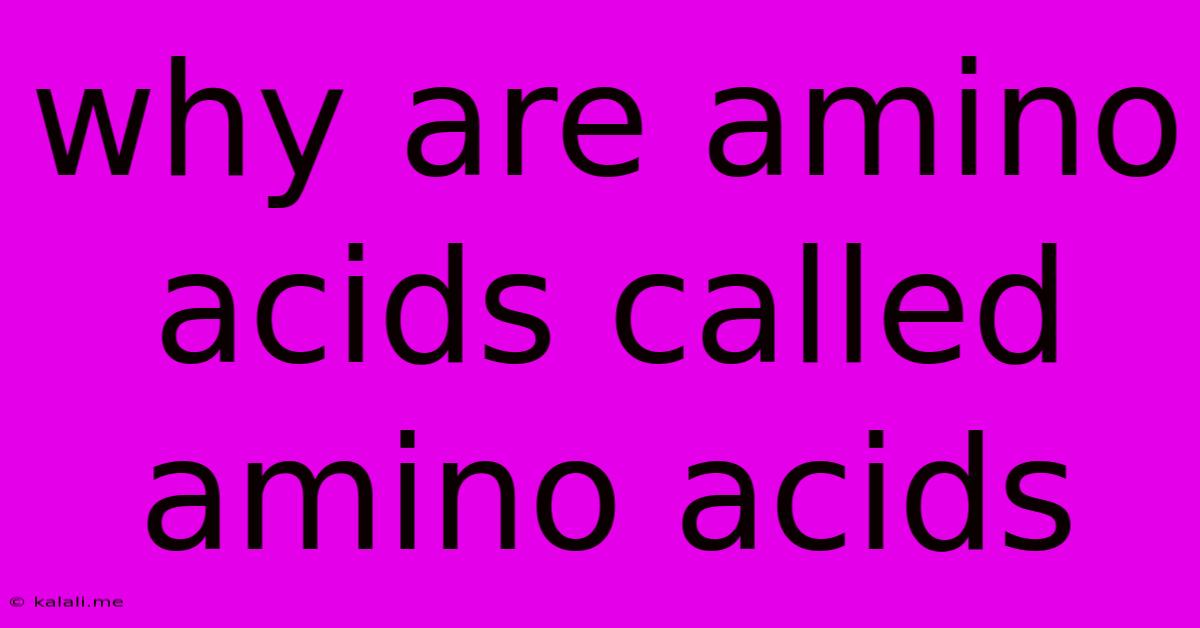Why Are Amino Acids Called Amino Acids
Kalali
Jun 09, 2025 · 2 min read

Table of Contents
Why Are Amino Acids Called Amino Acids? A Deep Dive into the Nomenclature
Amino acids are the fundamental building blocks of proteins, crucial for countless biological processes. But why are they called amino acids? The name itself reveals their chemical structure, a combination of two functional groups: an amino group and an acid group. This article will delve into the specifics, explaining the etymology and significance of this name.
Understanding the name "amino acid" requires understanding its two core components:
1. The Amino Group (-NH₂)
The "amino" part refers to the presence of an amino group (-NH₂) attached to a carbon atom. This amino group is characterized by a nitrogen atom bonded to two hydrogen atoms. It's this nitrogen-containing group that gives amino acids their basic properties – they can accept a proton (H+), acting as a weak base. This property plays a vital role in their function within proteins and biochemical reactions. Different types of amino acids may also have additional amino groups in their side chains, further impacting their properties.
2. The Carboxylic Acid Group (-COOH)
The "acid" part signifies the presence of a carboxylic acid group (-COOH), also attached to the same central carbon atom. This group consists of a carbon atom double-bonded to an oxygen atom and single-bonded to a hydroxyl group (-OH). Carboxylic acids are known for their acidic properties; they can donate a proton (H+), behaving as a weak acid. This contributes to the overall acidic nature of amino acids, influencing their behavior in various biological environments. The carboxyl group also participates in peptide bond formation, linking amino acids together to create protein chains.
The Central Carbon Atom: The Alpha Carbon
Both the amino and carboxyl groups are typically attached to the same carbon atom, known as the alpha (α) carbon. This alpha carbon is also bonded to a hydrogen atom and a variable side chain (R group). This R group differs amongst the 20 standard amino acids, determining their unique chemical properties, such as size, charge, and polarity. The variation in R groups is what allows for the vast diversity of proteins found in nature.
Putting it Together: The Name Reflects the Structure
The name "amino acid" perfectly encapsulates the fundamental chemical structure of these molecules: they possess both an amino group and a carboxylic acid group, attached to a central alpha carbon. This simple, yet descriptive, name directly reflects the core chemical components that dictate their properties and functions within living organisms. Understanding this nomenclature provides a critical foundation for grasping the complexities of protein structure, function, and biosynthesis.
In conclusion, the term "amino acid" is not arbitrary; it's a precise reflection of the molecule's essential chemical components. This precise naming convention aids scientists in understanding and classifying these crucial biological building blocks, crucial for everything from enzyme function to structural support within cells.
Latest Posts
Latest Posts
-
Refrigerator Vent Between Fridge And Freezer Blocked
Jun 09, 2025
-
3 Generations Of Men In The Bible
Jun 09, 2025
-
How Long Between Coats Of Stain
Jun 09, 2025
-
How Do Real Estate Agents Get Paid For Rentals
Jun 09, 2025
-
How To Get Rid Of New Carpet Smell
Jun 09, 2025
Related Post
Thank you for visiting our website which covers about Why Are Amino Acids Called Amino Acids . We hope the information provided has been useful to you. Feel free to contact us if you have any questions or need further assistance. See you next time and don't miss to bookmark.